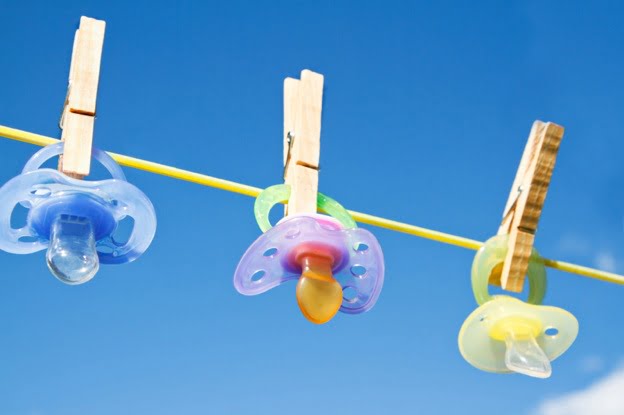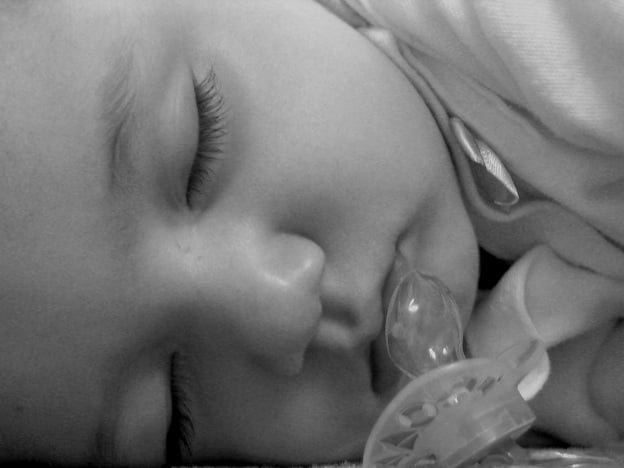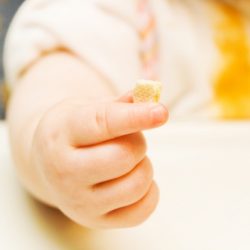SingaporeMotherhood | Parenting
July 2013
Bye Bye Pacifier!

Binky, paci, dummy, “nee tu”, “chi chi” – call it what you will. That artifical teat represents comfort and security to many children around the world and a miraculous off-switch to frazzled mothers who just want their cranky baby to stop fussing and hopefully, go to sleep.
Ms Jessie Ooh, Lead Psychologist, Department of Paediatrics, National University Hospital, says, “Pacifier use is highly associated with the need for a sucking reflex from the child. Sucking has a strong soothing and calming effect for the baby.”
[banner][/banner]
Dr Harvey Karp, a U.S. pediatrician and author of Happiest Baby on The Block, recommends giving an infant something to suck on as part of his “5 S’s” technique of calming a fussy baby. (The other S’s include swaddling, holding the infant on his side/stomach, saying “Shhh” loudly in the baby’s ear and swinging.)
The 5 S’s worked well for my daughter when she was an infant and as she grew older, we gradually dropped the number of steps required to calm her until all we had was the pacifier.
Now at the grand old age of two, it was time for Caitlyn to give that up. She was already day-time potty-trained and had also given up her milk bottles. I knew getting Caitlyn to give up her beloved pacifier would be no easy task and I was afraid that the longer I delayed, the harder it would be for her to give it up. I also did not want to risk her teeth being pushed out of shape.
As Dr Catherine Hong, Consultant, Discipline of Orthodontics and Paediatric Dentistry, National University Hospital shared, “The use of pacifier is not associated with the development of dental decay unless it is dipped into something sweet (like honey) prior to giving it to the child. However, the use of pacifiers beyond 48 months (four years of age) has been shown to cause misalignment of the teeth (crooked teeth) and the American Dental Association and the American Academy of Pediatric Dentistry both recommend that pacifier use be discouraged after four years of age.”
As a tentative step towards getting my daughter off the pacifer, I showed her the “Bye bye Binky!” video clip featuring her favourite furry red monster, Elmo, bidding goodbye to his pacifier. Her response was to clutch her pacifiers (she has two) more tightly and say she didn’t want to watch the video anymore.
Seeing how affected she was, I decided to postpone the inevitable to a later date. I promised myself that we would start the process after her third birthday, which was a few months away. As it turned out, fate had a different plan.
We were getting ready for bed a few weeks after I showed her clip. And horror of horrors! We couldn’t find her pacifiers! Not even one. The girl had somehow managed to misplace them.
The whole family searched high and low but they were just not to be found. As we searched, I realised it was the perfect opportunity to completely wean her off the pacifier.
By now, my daughter has been transformed into a banshee, thrashing wildly on the floor and wailing for her pacifier. Her Daddy was all ready to make a late night run to the shops to get a new one.
I was tempted to breakout the spare pacifier I had hidden in the cupboard, but I wanted to see if she could go to sleep without it. So with every ounce of self-control I could muster, I told her the pacifiers were missing and that we’d get her a new one tomorrow.
That night, just before she fell asleep, she held my hand and asked tearfully, “Where’s my pacifer, mummy?” Seeing her so upset, my heart broke and I almost caved in to give her the spare pacifier.
While this may seem like a rather abrupt way of getting rid of the pacifier, Caitlyn had actually been gradually weaning from it. We went from having it on hand all the time, to not using it while in school, and then finally using it only at home and during naps and bedtimes. By the time the pacifiers went missing, she had been using the pacifiers only during bedtimes.
Ms Ooh said: “Sudden withdrawal is not recommended as that may increase the anxiety during bedtimes which are typically long periods of pacifier usage. The gradual fading of the use of the pacifier is therefore recommended.”
So Caitlyn got the spare pacifer the next day and again, I resolved to re-visit the issue after her third birthday. It was not meant to be. The spare pacifer went missing again a couple of weeks later. This time I really didn’t have any pacifiers on hand. So in a flash of inspiration, I told Caitlyn that we could get either a new toy or a new pacifier the next day. To my surprise, she calmly said she wanted a new toy. I couldn’t belive my ears! I asked her again and got the same answer.
The next day at the mall, I asked her again if she would rather a new toy or a new pacifer. Again, she said rather adamantly, “New toy”.
And so in return for a new Spiderman figurine, Caitlyn gave up her pacifer. She never asked for her pacifier again and told everyone she met that her pacifier had gone missing.
I found her pacifiers one day while tidying up her toys. As I closed my palm around the little pacifiers, I realised we had come to the end of a chapter in her development and allowed myself a little bittersweet moment to remember how far my small and helpless little baby had come. When did she become this little person capable of dressing herself and making decisions? Throwing the pacifiers in the trash and firmly closing the lid, I prepared to pick up my daughter from school.
All content from this article, including images, cannot be reproduced without credits or written permission from SingaporeMotherhood.
Follow us on Facebook, Instagram, and Telegram for the latest article and promotion updates.






